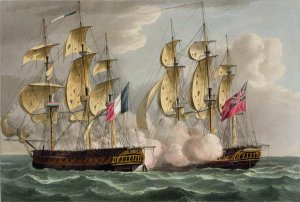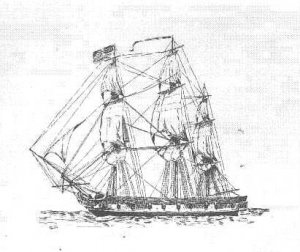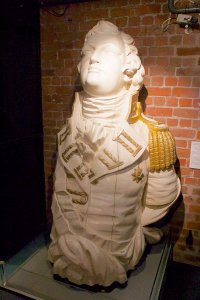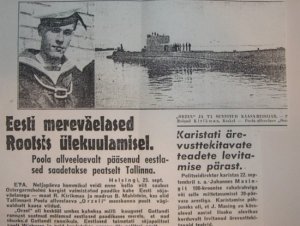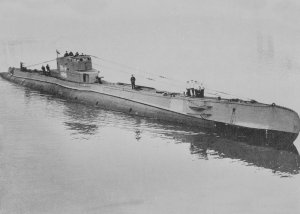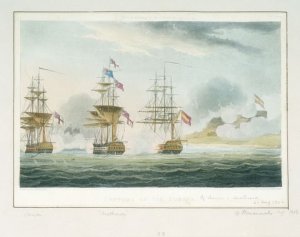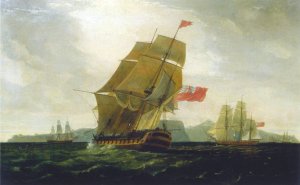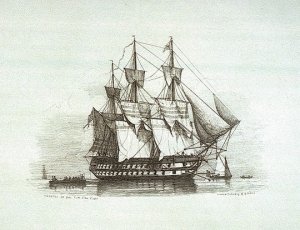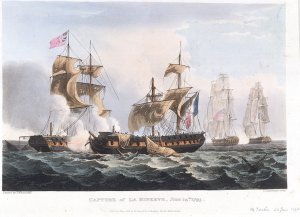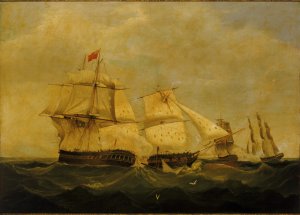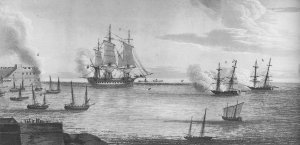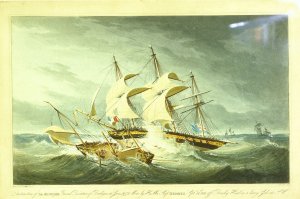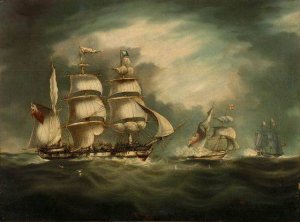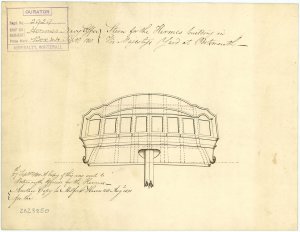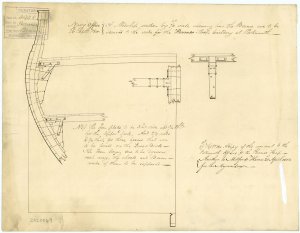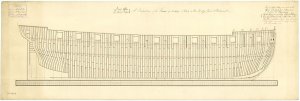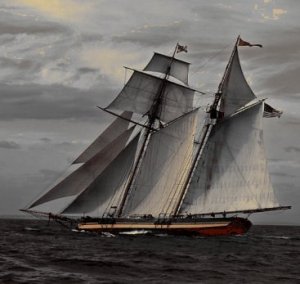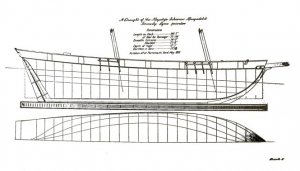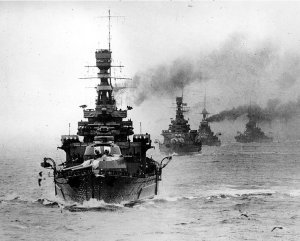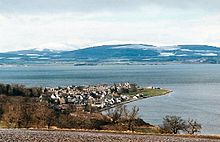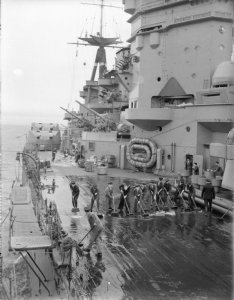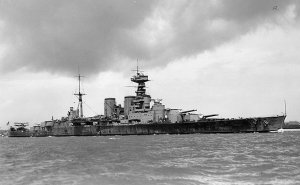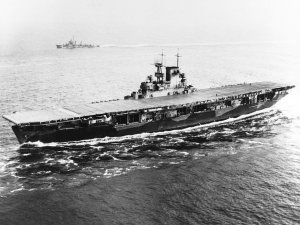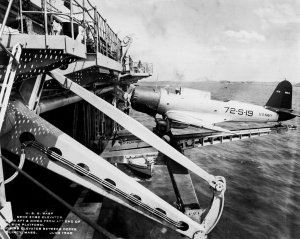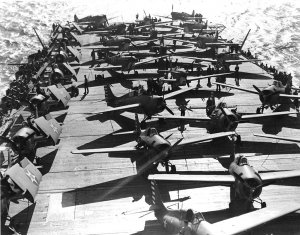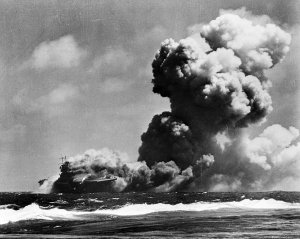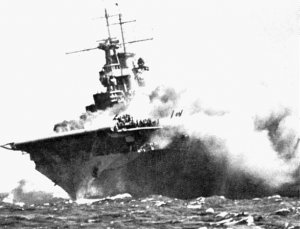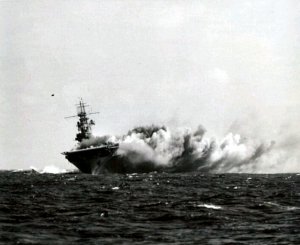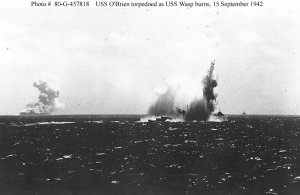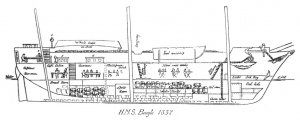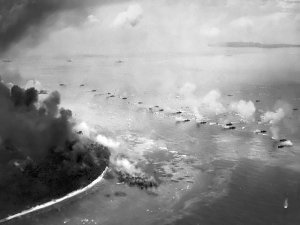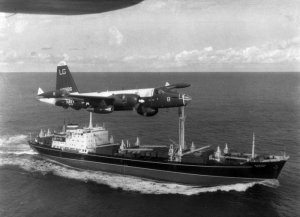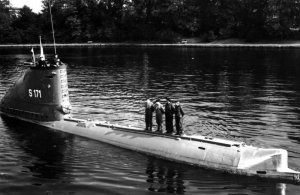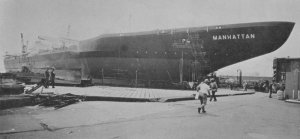Today in Naval History - Naval / Maritime Events in History
13 September 1801 - HMS Lark (16), Lt. Johnstone, captured Spanish privateer schooner Esperance, within the Portillo Reefs, Cuba.
HMS Lark was a 16-gun ship sloop of the Cormorant class, launched in 1794 at Northfleet. She served primarily in the Caribbean, where she took a number of prizes, some after quite intensive action. Lark foundered off San Domingo in August 1809, with the loss of her captain and almost all her crew.
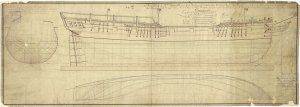
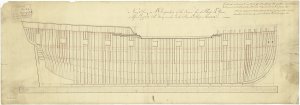
Lark's next action occurred on 13 September 1801. With Lieutenant James Johnstone as acting captain, Lark chased a Spanish privateer schooner along the coast of Cuba until evening, when the schooner took refuge within the Portillo Reefs. Johnstone sent his yawl and cutter, each with sixteen men, including officers, to capture her. The privateer, which was armed with a long 8-pounder and two 4-pounders, opened fire on the boarding party. Still, the British prevailed, though they lost one man killed and a midshipman and 12 sailors wounded. The Spanish lost 21 dead, including their captain Joseph Callie, and six wounded; Lark took the remainder of the 45 men crew prisoner. The privateer was the Esperanza out of Santiago, and in the previous month she had taken the British sloop Eliza and the brig Betsey.
The very long and successful career of the HMS Lark you can read in detail in wikipedia
Loss
Unfortunately, on 3 August 1809, Lark foundered in a gale off Cape Causada (Point Palenqua), San Domingo. She was at anchor when the gale struck. She set sail at daybreak to get out to sea but while she was shortening sail a squall struck that turned her on her side. At that point a heavy sea struck her and she filled rapidly with water. She sank within 15 minutes, taking most of her crew with her. Some of her crew survived by hanging on to floating wreckage. However, by evening, when the Cruizer-class brig-sloop Moselle arrived, Commander Nicholas and all but three men of her crew of 120 were dead. Moselle then rescued the three survivors. Nicholas had just been promoted to post-captain with orders to command Garland.
The Cormorant class were built as a class of 16-gun ship sloops for the Royal Navy, although they were re-rated as 18-gun ships soon after completion.
Design
The two Surveyors of the Navy – Sir William Rule and Sir John Henslow – jointly designed the class. A notation on the back of the plans held at the National Maritime Museum, Greenwich, states that the designers based their plan on the lines of the captured French sloop Amazon, captured in 1745.
The Admiralty ordered six vessels to this design in February 1793; it ordered a seventh vessel in the following year. These ships were initially armed with sixteen 6-pounder guns, later supplemented with eight 12-pounder carronades (6 on the quarter deck and 2 on the forecastle). The 6-pounder guns were eventually replaced by 24-pounder carronades
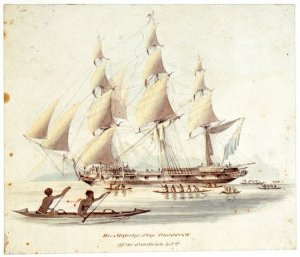
His Majesty's ship Blossom off the Sandwich Islands
Twenty-four more were ordered to the same design in 1805 – 1806, although in this new batch 32-pounder carronades were fitted instead of the 6-pounder guns originally mounted in the earlier batch; the 12-pounder carronades were replaced by 18-pounders, and some ships also received two 6-pounders as chase guns on the forecastle.
Of this second batch one ship (Serpent) was cancelled and another (Ranger) completed to a slightly lengthened variant of the design.
Ships of the class
Batch 1 (with 6-pounder guns)
Cormorant - 2 January 1794 - Blew up by accident on 24 December 1796
Favourite - 1 February 1794 - Captured by the French 6 January 1806; retaken 27 January 1807 and renamed Goree; broken up in 1817,
Hornet - 3 February 1794 - Sold on 30 October 1817
Lynx - 14 February 1794 - Sold on 28 April 1813
Lark - 15 February 1794 - Foundered on 3 August 1809
Hazard - 3 March 1794 - Sold on 30 October 1817
Stork - 29 November 1794 - Sold on 30 May 1816
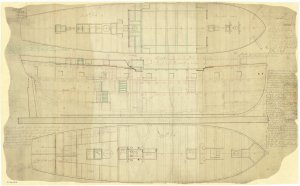
Batch 2 (with 32-pounder carronades)
Hyacinth - 30 August 1806 - Broken up in December 1820
Sabrina - 1 September 1806 - Sold on 18 April 1816
Herald - 27 December 1806 - Broken up in September 1817
Anacreon - 1 May 1813 - Foundered with all hands on 28 February 1814
Rosamund - 27 January 1807 - Sold on 14 December 1815
Fawn - 22 April 1806 - Sold on 20 August 1818
Myrtle1 - 2 October 1807 - Broken up in June 1818
Acorn - 30 October 1807 - Broken up in May 1819
Racoon - 30 March 1808 - Convict prison ship in 1819; sold in August 1838
North Star - 21 April 1810 - Sold 6 March 1817
Hesper - 3 July 1809 - Sold 8 July 1817
Cherub - 27 December 1806Sold on 13 January 1820
Minstrel - 25 March 1807 - Sold 6 March 1817
Wanderer - 29 September 1806 - Sold 6 March 1817; became a whaling ship and then merchantman on the North Atlantic before her crew abandoned her in October 1827 as she was in a sinking state.
Sapphire - 11 November 1806 - Sold 18 April 1822
Blossom - 10 December 1806 - Broken up in August 1848
Partridge - 15 July 1809 - Broken up in September 1816
Egeria1 - 31 October 1807 - Receiving ship at Devonport from 1825; broken up 1864
Favourite - 13 September 1806 - Broken up in February 1821
Tweed - 10 January 1807 - Wrecked off Newfoundland 5 November 1813
Ranger - 5 September 1807 - Broken up in February 1814
.Jalouse - 13 July 1809 - Sold 8 March 1819
Serpent - Cancelled 8 September 1810
Dauntless - 20 December 1808 - Sold for breaking on 27 January 1825
https://en.wikipedia.org/wiki/HMS_Lark_(1794)
http://collections.rmg.co.uk/collec...el-324976;browseBy=vessel;vesselFacetLetter=L
https://en.wikipedia.org/wiki/Cormorant-class_ship-sloop
13 September 1801 - HMS Lark (16), Lt. Johnstone, captured Spanish privateer schooner Esperance, within the Portillo Reefs, Cuba.
HMS Lark was a 16-gun ship sloop of the Cormorant class, launched in 1794 at Northfleet. She served primarily in the Caribbean, where she took a number of prizes, some after quite intensive action. Lark foundered off San Domingo in August 1809, with the loss of her captain and almost all her crew.


Lark's next action occurred on 13 September 1801. With Lieutenant James Johnstone as acting captain, Lark chased a Spanish privateer schooner along the coast of Cuba until evening, when the schooner took refuge within the Portillo Reefs. Johnstone sent his yawl and cutter, each with sixteen men, including officers, to capture her. The privateer, which was armed with a long 8-pounder and two 4-pounders, opened fire on the boarding party. Still, the British prevailed, though they lost one man killed and a midshipman and 12 sailors wounded. The Spanish lost 21 dead, including their captain Joseph Callie, and six wounded; Lark took the remainder of the 45 men crew prisoner. The privateer was the Esperanza out of Santiago, and in the previous month she had taken the British sloop Eliza and the brig Betsey.
The very long and successful career of the HMS Lark you can read in detail in wikipedia
Loss
Unfortunately, on 3 August 1809, Lark foundered in a gale off Cape Causada (Point Palenqua), San Domingo. She was at anchor when the gale struck. She set sail at daybreak to get out to sea but while she was shortening sail a squall struck that turned her on her side. At that point a heavy sea struck her and she filled rapidly with water. She sank within 15 minutes, taking most of her crew with her. Some of her crew survived by hanging on to floating wreckage. However, by evening, when the Cruizer-class brig-sloop Moselle arrived, Commander Nicholas and all but three men of her crew of 120 were dead. Moselle then rescued the three survivors. Nicholas had just been promoted to post-captain with orders to command Garland.
The Cormorant class were built as a class of 16-gun ship sloops for the Royal Navy, although they were re-rated as 18-gun ships soon after completion.
Design
The two Surveyors of the Navy – Sir William Rule and Sir John Henslow – jointly designed the class. A notation on the back of the plans held at the National Maritime Museum, Greenwich, states that the designers based their plan on the lines of the captured French sloop Amazon, captured in 1745.
The Admiralty ordered six vessels to this design in February 1793; it ordered a seventh vessel in the following year. These ships were initially armed with sixteen 6-pounder guns, later supplemented with eight 12-pounder carronades (6 on the quarter deck and 2 on the forecastle). The 6-pounder guns were eventually replaced by 24-pounder carronades

His Majesty's ship Blossom off the Sandwich Islands
Twenty-four more were ordered to the same design in 1805 – 1806, although in this new batch 32-pounder carronades were fitted instead of the 6-pounder guns originally mounted in the earlier batch; the 12-pounder carronades were replaced by 18-pounders, and some ships also received two 6-pounders as chase guns on the forecastle.
Of this second batch one ship (Serpent) was cancelled and another (Ranger) completed to a slightly lengthened variant of the design.
Ships of the class
Batch 1 (with 6-pounder guns)
Cormorant - 2 January 1794 - Blew up by accident on 24 December 1796
Favourite - 1 February 1794 - Captured by the French 6 January 1806; retaken 27 January 1807 and renamed Goree; broken up in 1817,
Hornet - 3 February 1794 - Sold on 30 October 1817
Lynx - 14 February 1794 - Sold on 28 April 1813
Lark - 15 February 1794 - Foundered on 3 August 1809
Hazard - 3 March 1794 - Sold on 30 October 1817
Stork - 29 November 1794 - Sold on 30 May 1816

Batch 2 (with 32-pounder carronades)
Hyacinth - 30 August 1806 - Broken up in December 1820
Sabrina - 1 September 1806 - Sold on 18 April 1816
Herald - 27 December 1806 - Broken up in September 1817
Anacreon - 1 May 1813 - Foundered with all hands on 28 February 1814
Rosamund - 27 January 1807 - Sold on 14 December 1815
Fawn - 22 April 1806 - Sold on 20 August 1818
Myrtle1 - 2 October 1807 - Broken up in June 1818
Acorn - 30 October 1807 - Broken up in May 1819
Racoon - 30 March 1808 - Convict prison ship in 1819; sold in August 1838
North Star - 21 April 1810 - Sold 6 March 1817
Hesper - 3 July 1809 - Sold 8 July 1817
Cherub - 27 December 1806Sold on 13 January 1820
Minstrel - 25 March 1807 - Sold 6 March 1817
Wanderer - 29 September 1806 - Sold 6 March 1817; became a whaling ship and then merchantman on the North Atlantic before her crew abandoned her in October 1827 as she was in a sinking state.
Sapphire - 11 November 1806 - Sold 18 April 1822
Blossom - 10 December 1806 - Broken up in August 1848
Partridge - 15 July 1809 - Broken up in September 1816
Egeria1 - 31 October 1807 - Receiving ship at Devonport from 1825; broken up 1864
Favourite - 13 September 1806 - Broken up in February 1821
Tweed - 10 January 1807 - Wrecked off Newfoundland 5 November 1813
Ranger - 5 September 1807 - Broken up in February 1814
.Jalouse - 13 July 1809 - Sold 8 March 1819
Serpent - Cancelled 8 September 1810
Dauntless - 20 December 1808 - Sold for breaking on 27 January 1825
https://en.wikipedia.org/wiki/HMS_Lark_(1794)
http://collections.rmg.co.uk/collec...el-324976;browseBy=vessel;vesselFacetLetter=L
https://en.wikipedia.org/wiki/Cormorant-class_ship-sloop



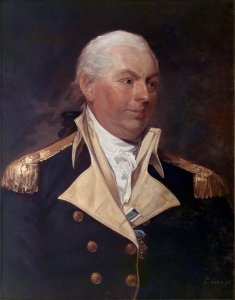
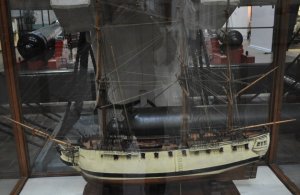
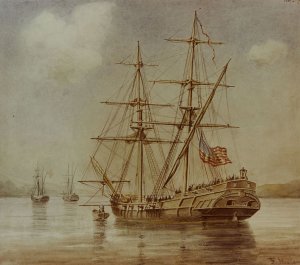
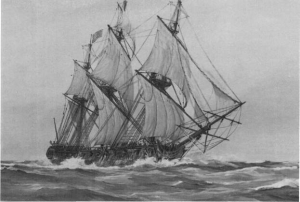
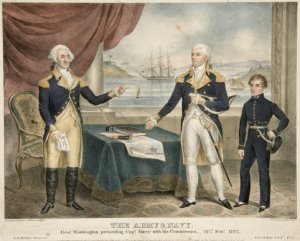
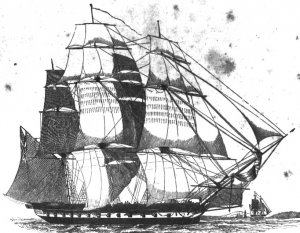
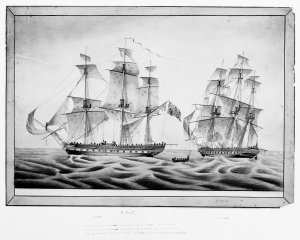

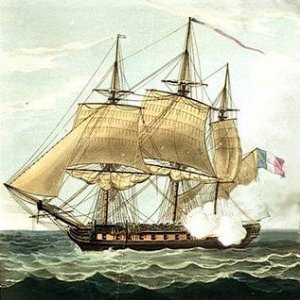
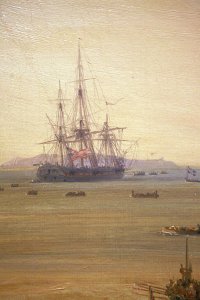
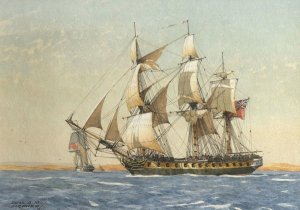
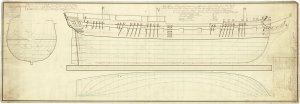
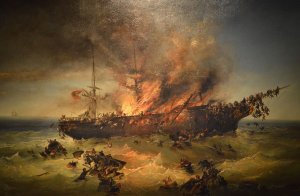
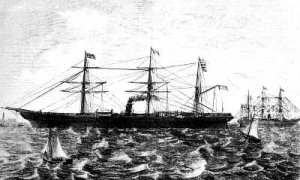
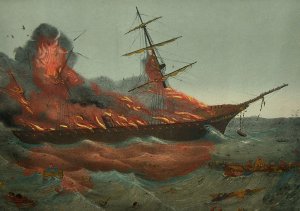
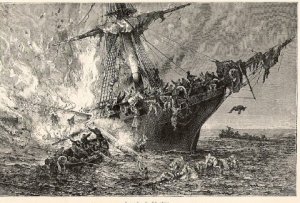
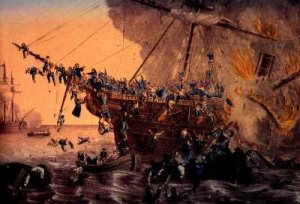
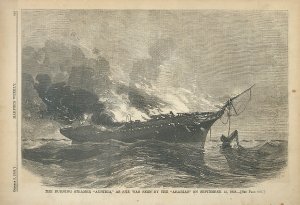
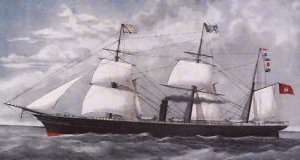
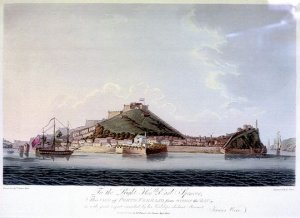
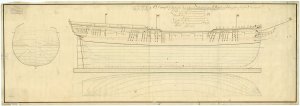
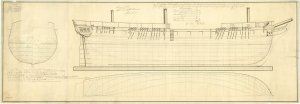
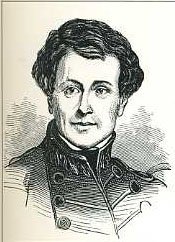
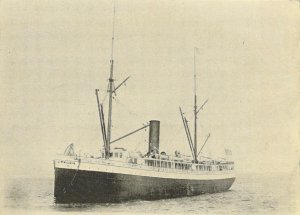
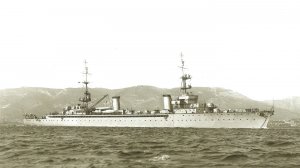
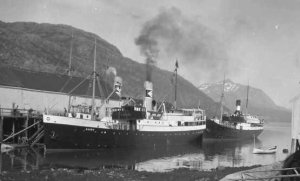
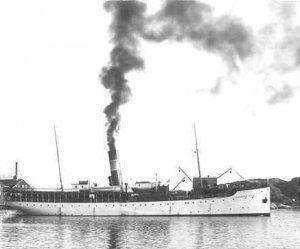

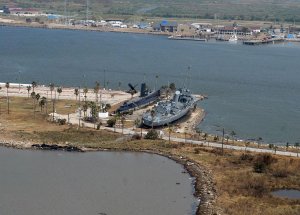
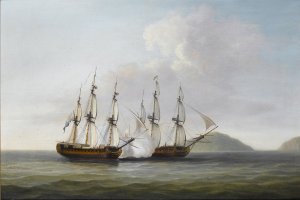
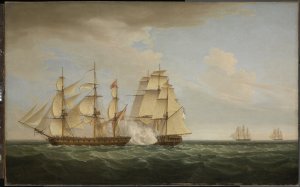
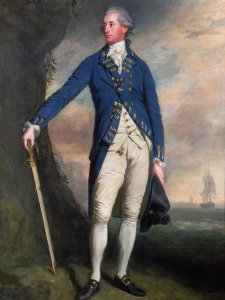

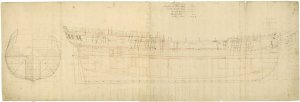
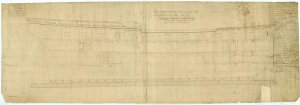
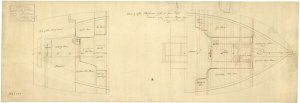
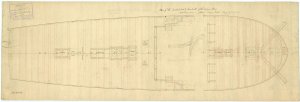



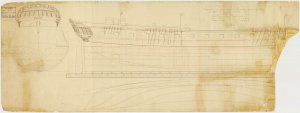
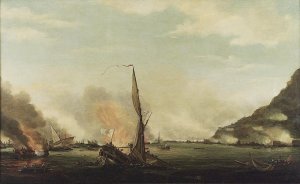

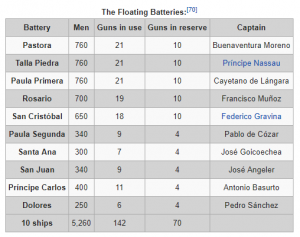
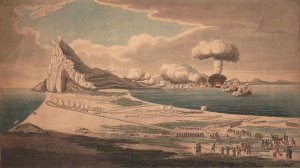


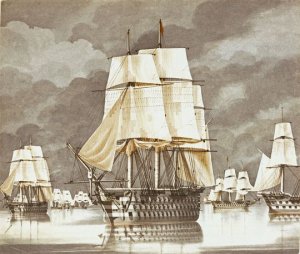
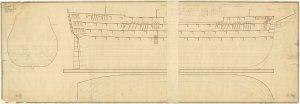
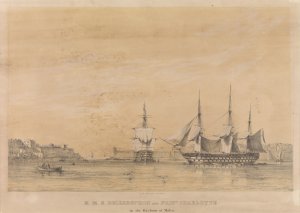
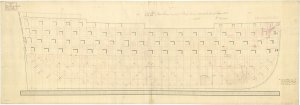
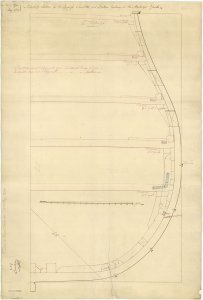


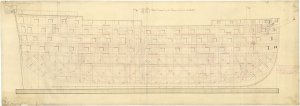


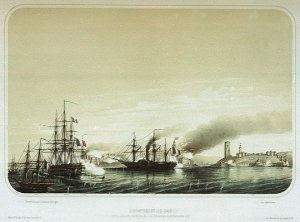

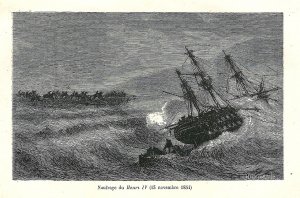
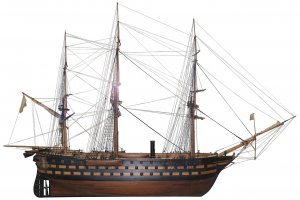
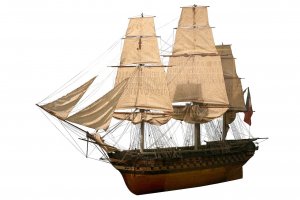
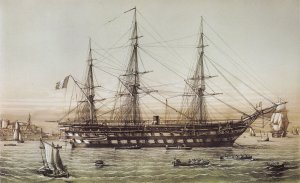


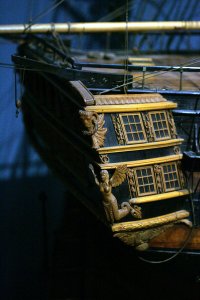
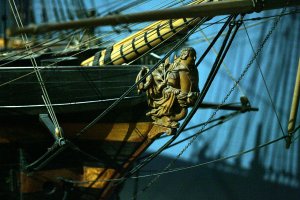
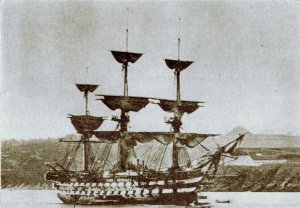
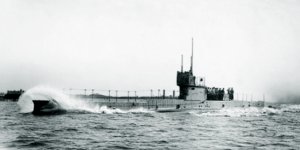

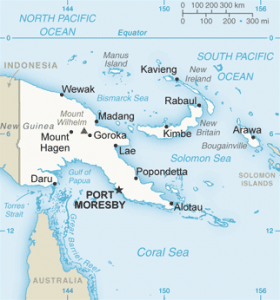
 , Cptn. Paul.
, Cptn. Paul. 